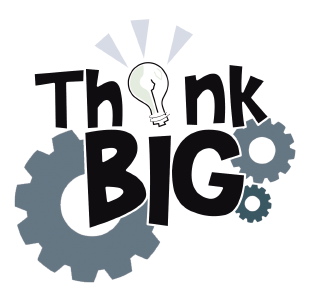Sometime ago I wrote two posts in this forum:
Expect a Microsoft, Google or facebook out of India? Won’t happen unless we THINK BIG!
and
How to Think Big in Software Products? .
This post is a continuation of this thought process.
What are the advantages for me in Thinking Big if I am a product startup?
Again, thinking big does not mean abandoning what you are doing currently for something fancier but extending your thought process in figuring out the bigger picture in which your product, consumer or enterprise, fits in. And communicating it to all stake holders every chance you get – first your employees, then potential investors, current investors, customers, prospects, your local government, government agencies and so on!
It needs to become part of your pitch – and you need three or four versions that – 30 seconds for someone with whom you share an elevator ride, 2 minutes when you are in a corner during a networking sesssion at a conference and 5 t0 10 minutes when you are in a pitching competition, 30 min to 45 min when you have a one hour meeting with an investor! All including a phrase or a sentence on what the big picture is!
Now, here are 10 solid advantages in Thinking Big if you are product start-up.
1. Hire Good People – Good people don’t join a company. They join a mission with a clear vision and big thinking! Especially in today’s Indian product scene, many potential employees have a fair idea of the risks they are taking with a start-up company and may join anyway. But you need to sell them as much as you sell your investors. And they would make all the difference. It’s easy to hire average people. It takes work to hire good people and they are inspired by big thinkers. That’s how they address their own anxieties about taking a risk with you and your start-up.
2. Convince Potential Investors – In software product companies, investors are looking for a large potential addressable market even if your current product addresses a small part of it currently. If it is a consumer-facing product, you need to chart a large enough course for ramp up and showing hockey stick shaped growth. So unless you think big, this is not going to happen. They will not be convinced. If it is an enterprise product, your bigger vision must include how your current product fits in naturally with additional features and additional products you are planning. How will you scale? Thinking big helps you address how you will scale.
3. Help explore partnerships – Even if your current product is a small part of a larger market, thinking about how it fits it with the bigger picture helps you identify partners early. They will complete the other parts of the bigger picture. Given your bandwidth with people, money and other resources, you will never be able to build the products your potential partners have already built. It will help you paint the larger picture for your partners and help sign them on.
4. Spur Internal Innovation – Thinking about the bigger picture and conveying it clearly to your employees gives them a clear sense of how they can come up with good ideas and paint within the lines you have drawn for them.Somewhere I read a blog entry from the CEO of a startup product company wondering about how to keep employees’ innovation focused and useful and not stray too much into wild and unconnected ideas. If you are a consumer focused company in the mobile space, there may be hardly any point in your employees coming up with new ideas in the enterprise space and vice-versa. Defining your mission in larger terms makes it clear for you and your employees, the boundaries within which they can innovate.
5. Have a Product Pipeline Ready – Thinking Big helps you prioritize your product pipeline beyond your current product. You can then outline this to all of your prospects and customers and obtain their feedback. Remember that unlike software services companies, in product companies you don’t get paid to do requirements gathering for your next products. That’s all at your own expense. Before you actually write a line of code, you can sound out your future plans with your prospects and customers and refine, rearrange your own plans! You may discover that products that you thought were the hottest ideas were not and discover the real products they need. Talking about a product pipeline with prospects and customers and outlining their reactions and feedback have a lot of credibility with your investors. Plus you can have contacts and phone numbers for them to do their due diligence. And rest assured, they will do it; you are just prepared for it, ahead of time!
6. Helps you Pivot to somewhere close when you need to – Sooner or later every eventually successful product company had to pivot to something else. Twitter was dreamed up by one employee when the parent company was running out of money and they had to come up with some other idea. Thinking Big and having an idea of where your original idea fits in gives you a lot more options for you to pivot, especially if you have sounded them out with your prospects and customers. When you pivot you may be pivoting to something that your prospects and customers already told you they wanted!
7. Acquire Other Companies for Growth – When you are successful with your initial idea, Thinking Big has helped you already visualize where you fit in and what other start-up companies are there for you to acquire when you go raise additional rounds of money. Flipkart is going around acquiring other companies that deal with similar or different products or operating in other geographic areas. Whether you are a consumer focused startup or an enterprise focused one, you are always a part of the larger picture. You may not be able to address all of the larger market but it doesn’t cost you anything to think of where you fit in!
8. Be Acquired – This is the reverse of the previous advantage. Investors participate in software product companies for the possible big exit, either through an IPO or an acquisition. If you can think of the larger picture, it helps you get in the sights of those that are bigger than you and can acquire you. They complete their bigger picture, you and your investors get your exit. Everybody wins!
9. Become Thought Leaders and Gain Credibility – Thinking Big allows you to do a lot of subtle marketing through Thought Leadership. When we built an Analytics company for BPOs and Call Centers, we became thought leaders in Continuous Process Improvement which is a logical extension of what you do once you collect metrics about a process. What’s ahead of what you do? This helps you provide for free, something that’s of value to your prospects; and is not pitching your products directly, and is a lot of subtle marketing. Writing a blog about the features in your product is OK but is not compelling enough for your users to come back for information useful for them often. And it can be done, no matter what you do. You do a start-up company that does imaging on a mobile phone, start writing about image processing in general. If you are doing a SaaS enterprise play in HR in India, write about HR problems that are unique to India and write about companies that address them in a unique way. They won’t consider it spam when you send information useful to them every month and not too many things about your own product! Keep your product information to “exciting new features coming!”.
10. Helps you get started with Guerilla Marketing – Collect published online articles about the larger market you are addressing. Post them on your facebook page, tweet them and Google+ them! That’s not spam if you are providing links to interesting approaches, news and images. And you are in front of them every week, month or quarter with your brand!
As long as your going to be thinking anyway, think big. – Donald Trump























